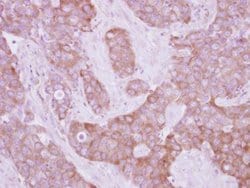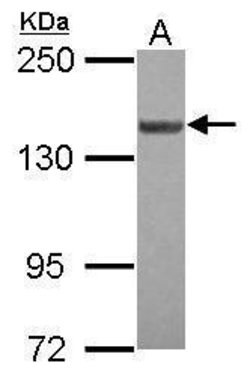Promotional price valid on web orders only. Your contract pricing may differ. Interested in signing up for a dedicated account number?
Learn More
Learn More
Invitrogen™ LOK Polyclonal Antibody
Rabbit Polyclonal Antibody
Supplier: Invitrogen™ PA529404
Description
Recommended positive controls: A431, Raji, HeLa. Predicted reactivity: Mouse (97%), Rat (97%), Zebrafish (82%), Xenopus laevis (84%), Chicken (90%), Bovine (96%). Store product as a concentrated solution. Centrifuge briefly prior to opening the vial.
Ubiquitin: exists either covalently attached to another protein, or free (unanchored). When covalently bound, it is conjugated to target proteins via an isopeptide bond either as a monomer (monoubiquitin), a polymer linked via different Lys residues of the ubiquitin (polyubiquitin chains) or a linear polymer linked via the initiator Met of the ubiquitin (linear polyubiquitin chains). Polyubiquitin chains, when attached to a target protein, have different functions depending on the Lys residue of the ubiquitin that is linked: Lys-6-linked may be involved in DNA repair; Lys-11-linked is involved in ERAD (endoplasmic reticulum-associated degradation) and in cell-cycle regulation; Lys-29-linked is involved in lysosomal degradation; Lys-33-linked is involved in kinase modification; Lys-48-linked is involved in protein degradation via the proteasome; Lys-63-linked is involved in endocytosis, DNA-damage responses as well as in signaling processes leading to activation of the transcription factor NF-kappa-B. Linear polymer chains formed via attachment by the initiator Met lead to cell signaling. Ubiquitin is usually conjugated to Lys residues of target proteins, however, in rare cases, conjugation to Cys or Ser residues has been observed. When polyubiquitin is free (unanchored-polyubiquitin), it also has distinct roles, such as in activation of protein kinases, and in signaling. 60S ribosomal protein L40: component of the 60S subunit of the ribosome. Ribosomal protein L40 is essential for translation of a subset of cellular transcripts, and especially for cap-dependent translation of vesicular stomatitis virus mRNAs.
Specifications
| LOK | |
| Polyclonal | |
| Unconjugated | |
| stk10 | |
| Gek1; germ cell kinase 1; Lok; Lymphocyte-oriented kinase; mKIAA4026; PRO2729; serine/threonine kinase 10; serine/threonine-protein kinase 10; similar to serine/threonine kinase 10; STK10; zgc:63495 | |
| Rabbit | |
| Antigen affinity chromatography | |
| RUO | |
| 6793 | |
| Store at 4°C short term. For long term storage, store at -20°C, avoiding freeze/thaw cycles. | |
| Liquid |
| Immunohistochemistry (Paraffin), Western Blot, Immunocytochemistry | |
| 1 mg/mL | |
| PBS with 1% BSA, 20% glycerol and 0.01% thimerosal; pH 7 | |
| O94804 | |
| stk10 | |
| Recombinant fragment corresponding to a region within amino acids 28 and 302 of Human LOK. | |
| 100 μL | |
| Primary | |
| Human | |
| Antibody | |
| IgG |
Safety and Handling
WARNING: Cancer - www.P65Warnings.ca.gov
Product Content Correction
Your input is important to us. Please complete this form to provide feedback related to the content on this product.
Product Title
Spot an opportunity for improvement?Share a Content Correction

